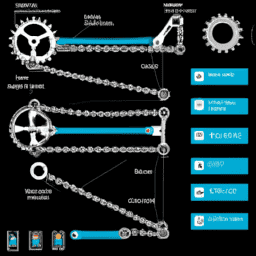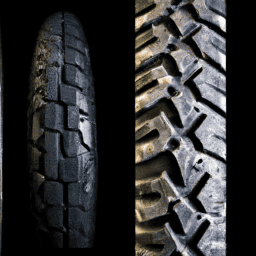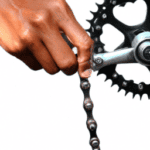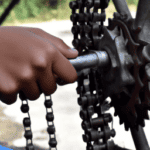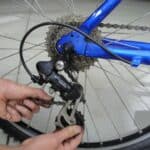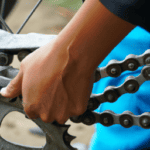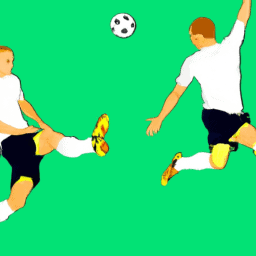Putting on a new bike chain might appear challenging, but if you have the necessary tools and a bit of expertise, it can be accomplished quickly.
In this article, I will guide you through the process of installing a new chain on your bicycle step by step, so you can get back out on the road with confidence.
Before we begin, it’s important to note that a worn or damaged chain can cause poor shifting and even damage to other parts of your bike, so it’s important to replace your chain when it starts to show signs of wear.
With that in mind, let’s get started on installing your new chain. Gather your tools, take a deep breath, and let’s dive in.
Key Takeaways
- Gather necessary tools, including a chain tool, pliers, and tape measure or ruler.
- Proper alignment of the derailleur and threading the chain through it correctly are crucial steps.
- Using the right size chain breaker tool and properly aligning it with the pin is important.
- Adjusting tension affects shifting and pedaling of the bike.
Gather the Necessary Tools
You’ll need a few tools to get started, so let’s gather ’em up! First, you’ll need a chain tool to remove and install the new chain.
It’s also a good idea to have a pair of pliers to help with any stubborn links. In addition, you’ll need a tape measure or ruler to determine the proper length of the new chain.
It’s important to note that there are different types of bicycle chains, so make sure you have the correct one for your bike. Additionally, having the proper chain length is crucial for a smooth and efficient ride.
Too short of a chain can cause damage to the bike’s components, while a chain that’s too long can result in poor shifting performance.
With these tools gathered, let’s move on to removing the old chain.
Remove the Old Chain
Before installing a new bicycle chain, it’s crucial to remove the old one first. To do this, I start by locating the master link. This is usually marked by a different color or has a unique shape.
Then, I use a chain breaker tool to break the chain at a point that’s convenient for removal. This will allow me to easily take off the old chain and prepare for the installation of the new one.
Locate the Master Link
First things first, finding the master link is crucial to properly installing a new bicycle chain. For example, when I replaced my chain, I had to search for the master link by closely examining each link until I found the one with a removable plate. The master link is also referred to as the quick link, connecting link, or power link. It is a special link found on some types of chains that allows for easy installation and removal of the chain without the need for a chain tool. The master link advantages are that it saves time and effort when replacing a chain, and it also allows for easy cleaning and maintenance of the chain.
Different chain types have different types of master links. The most common types of master links are the KMC Missing Link and the Shimano Quick Link. It is important to ensure that the master link you have matches the type of chain you are installing. Using the wrong type of master link can result in a chain failure and potential injury. Once you have located the master link, it is time to use the chain breaker tool to remove the old chain.
Use the Chain Breaker Tool
Now it’s time to grab the chain breaker tool and get rid of that old, worn-out chain – you don’t want to risk a dangerous chain failure while out on a ride. To properly use the chain breaker tool, follow these steps:
- Align the chain breaker tool with the pin that you want to remove.
- Tighten the tool’s screw until the pin starts to push out of the chain link.
- Loosen the screw and remove the tool from the chain.
- Use a pair of pliers to finish pushing the pin out of the link.
If you’re having trouble removing the pin, make sure you’re using the right size chain breaker tool and that the tool is properly aligned with the pin. If the pin is still stubborn, try using a pair of pliers to gently wiggle it back and forth until it loosens up.
Once you’ve removed the old chain, it’s time to move on to the next step and measure and cut the new chain.
With the old chain removed, it’s time to measure and cut the new chain to the appropriate length.
Measure and Cut the New Chain
To get your bicycle moving smoothly again, you’ll need to measure and cut the new chain to the correct length. Chain sizing is important in ensuring that the chain fits properly on your bicycle.
You can measure the length of your old chain and use that as a guide, or you can use the manufacturer’s instructions for chain compatibility. When cutting the new chain, it’s important to use a chain breaker tool to break the chain at the correct link.
Be sure to remove any excess links so that the new chain fits snugly on your bike. Once you have the correct length, you can move on to installing the new chain.
Install the New Chain
Now that we’ve measured and cut the new chain, it’s time to install it.
The first step is to thread the chain through the derailleur, making sure that it’s properly aligned with the gears.
Next, I use the chain tool to connect the ends of the chain, ensuring that the pin is pushed in all the way.
Finally, I check the tension of the chain and adjust it if necessary to ensure smooth and efficient shifting.
Thread the Chain Through the Derailleur
Don’t forget to thread the chain through the derailleur carefully, making sure it’s properly aligned. If the derailleur alignment is not adjusted properly, it can cause the chain to skip or even fall off during use.
To ensure proper alignment, follow these steps:
- Shift the chain to the smallest cog on the derailleur and the smallest chainring on the crankset.
- Check the alignment of the derailleur cage with the chain. It should be parallel to the chain and not touching it.
- If the alignment is off, adjust the high and low limit screws on the derailleur until it is in line with the chain.
Once the derailleur is properly aligned, thread the chain through it, starting from the bottom and working your way up to the top. Make sure the chain is properly seated on the derailleur pulleys and tensioned correctly.
With this step complete, it’s time to move on to the final step of using the chain tool to connect the ends of the chain.
Ensuring proper alignment of the derailleur and threading the chain through it correctly are crucial steps in installing a new chain. Skipping these steps or not doing them correctly can result in the chain falling off or skipping during use. So take your time and double-check your work to ensure a smooth and safe ride.
Use the Chain Tool to Connect the Ends
Next up, you’ll be using the chain tool to join the two ends of the chain together, creating a seamless connection that will keep your bike moving smoothly and effortlessly. This may seem like a daunting task, but with the right technique, it can be accomplished quickly and easily. Here are some tips for using a chain tool effectively:
- First, make sure the chain tool is properly aligned with the pin you want to push out. Use the adjustable jaw to center the tool on the chain link.
- Next, turn the handle of the chain tool clockwise to push the pin through the link. Be sure to apply steady pressure and keep the tool perpendicular to the chain.
- Once the pin is almost all the way through the link, stop turning the handle and use the pliers to carefully push it the rest of the way.
- Finally, turn the handle of the chain tool counterclockwise to loosen it and remove it from the chain.
It’s important to note some common mistakes to avoid when installing a bicycle chain. One of the most common is failing to properly align the chain tool with the pin, which can cause the pin to become stuck and potentially damage the chain. Another mistake is not applying enough pressure when pushing the pin through the link, which can result in a weak connection that may break while riding. With these tips in mind, you’ll be able to confidently use the chain tool to connect the ends of your chain and move on to the next step: checking the tension.
Now that the chain is connected, it’s time to check the tension to ensure optimal performance.
Check the Tension
After connecting the ends with the chain tool, it’s time to check the tension for optimal performance. Adjusting tension is crucial because it affects the shifting and pedaling of your bike. Too tight or too loose tension can cause chain slipping, wear and tear, and even accidents.
To check the tension, pull the chain downwards from the middle of the chainring. The chain should move up to 1/2 inch and not more or less. Common mistakes include over-tightening the chain, which can cause damage to the drivetrain, or leaving it too loose, which can cause the chain to fall off while biking.
After adjusting the tension, spin the pedals to ensure that the chain runs smoothly and quietly. It’s important to note that before testing the chain, it’s recommended to lubricate it first. This will ensure that the chain runs smoothly and prevents rust and corrosion.
Once you’ve lubricated and tested the chain, you’re ready to hit the road with your newly installed chain.
Lubricate and Test the Chain
Before riding your bike, it’s important to lubricate and test the chain to ensure smooth operation.
To apply lubricant, I first clean the chain with a degreaser and rag. Then, using a lubricant specifically designed for bike chains, I apply a drop of lubricant to each link. I make sure to evenly distribute the lubricant by rotating the pedals backwards and shifting through all the gears. Excess lubricant can be wiped off with a rag.
After applying lubricant, it’s important to check the alignment of the chain. I do this by shifting the gears to the smallest chainring and the smallest cassette cog. Then, I check the alignment of the chain by looking down from above the chain to see if it’s running straight. If it’s not aligned, I adjust the rear derailleur until the chain runs straight.
Lastly, I test the chain by shifting through all the gears and making sure they engage smoothly. With a properly lubricated and aligned chain, my bike runs smoothly and efficiently.
Frequently Asked Questions
How often should I replace my bicycle chain?
When my bicycle chain starts looking like a stretched-out slinky, I know it’s time to replace it. Chain wear indicators can also help determine when to replace. Some of the best replacement chain brands include Shimano and SRAM.
How do I know if my bicycle chain is too short or too long?
To determine if my bicycle chain is too short or too long, I measure the chain sizing using a chain gauge tool. If it’s too short, I’ll need to add links through chain lengthening.
Can I reuse the old chain pins when installing a new chain?
While it may be tempting to reuse old chain pins when installing a new chain, it is not recommended due to chain compatibility issues and the risk of breakage. Always check chain wear indicators and use new pins for optimal performance and safety.
What type of lubricant should I use on my bicycle chain?
For my bicycle chain, I prefer using wax lubricant due to its benefits of providing a clean and quiet ride, as well as reducing wear and tear. Alternatives to traditional chain lubricants include dry and ceramic lubes.
How do I adjust the tension of my new bicycle chain?
Adjusting the tension on a new bicycle chain is crucial for proper Bicycle chain maintenance. Troubleshooting tension issues can be a hassle, but with patience and precision, it can be done. Don’t worry, it’s not rocket science!
Conclusion
All in all, installing a bicycle chain requires a bit of patience and attention to detail, but it’s not a difficult task. With the right tools and a little bit of know-how, you can easily replace your old chain and get your bike running smoothly once again.
Just remember to measure your new chain carefully, cut it to the correct length, and install it with the right amount of tension. It’s also important to lubricate your new chain and test it out before hitting the road.
By taking the time to properly install and maintain your bike chain, you’ll be able to enjoy a smoother, more efficient ride for years to come. So, whether you’re a seasoned cyclist or just starting out, don’t be afraid to tackle this simple yet essential bike maintenance task.
Your bike – and your legs – will thank you for it.
